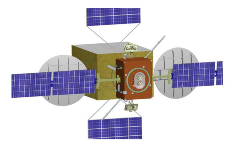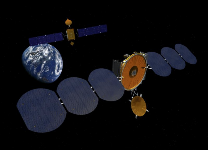Orbital Recovery
Created: 2023-08-10
Updated: 2025-09-06
Company - Orbital Recovery
- Founded
- Country
- 2001
- USA,UK
- Funding
- Yes, ?
Product/Service - Orbital Life Extension Vehicle (OLEV)
- Classification
- In-Space Transportation
- Category
- Satellite Life Extension
Active Debris Removal (ADR)
On-Orbit Servicing
- Fields
- In-Space Satellite Servicing
On-Orbit Servicing
- Status
- Dormant
- First launch
- 2007
Orbital Recovery's Responsive Commercial Space Tug for Life Extension Missions (2004)
- The OLEV is designed as a secondary payload on an Ariane V launch vehicle and carries a Hall Effect Thruster (HET) to execute GTO to GEO orbit raising, rendezvous and docking, and operations of the coupled spacecraft pair.
- The OLEV does not transfer fuel or otherwise interface with the parent spacecraft. The OLEV is designed to mate with any three axis stabilized spacecraft and has sufficient supplies to keep a 3000 kg parent spacecraft in geostationary orbit for up to an additional ten years of life.
Orbital Recovery Ltd. Signs Launch Ariane Services Contract For the ConeXpress Orbital Life Extension Vehicle “Space Tug” (May 2004)
The ConeXpress Orbital Life Extension Vehicle will be carried as a secondary payload on Ariane 5. Its liftoff mass will be approximately 1,200-1,400 kg. Developed by European industry, CX OLEV is designed to extend the useful lifetime of multi-million dollar telecommunications satellites by 10 years or more, and also is capable of rescuing satellites stranded in incorrect orbits.
“Ariane is known for setting the standards in commercial launch services, and we look forward to using Ariane 5 for our CX OLEV which will set the standards for the in-orbit servicing of telecommunications satellites,” said Phil Braden, Chief Executive Officer of Orbital Recovery Ltd.
In addition, the CX OLEV can be deployed to rescue spacecraft that have been placed in a wrong orbit, or which have become stranded in an incorrect orbital location during positioning maneuvers.
“We are pleased to provide launch services for this very innovative spacecraft, which continues Arianespace’s policy of working with promising new payloads and their operators,” said Arianespace Chief Executive Officer Jean-Yves Le Gall. “The mission flexibility of Ariane 5, combined with our experience in handling multi-satellite payloads, will enable the CX OLEV to be launched when needed to serve Orbital Recovery Ltd.’s mission requirements.”
Shaped like a truncated cone, the CX OLEV will continue to serve as a payload adapter for Ariane 5 missions, with the launcher’s primary satellite payload mounted atop it. Once the primary payload has been released, the CX OLEV will be deployed from the launcher to begin its own mission as an independent space tug.
The industry team developing CX OLEV is led by the Netherlands’ Dutch Space, and includes Germany’s DLR German Aerospace Center and Kayser-Threde. Aon Space is providing insurance brokering and risk management services.
Dutch Space Invests In Orbital Recovery (April 2004)
Orbital Recovery completes 2nd round financing for space tug (November 2004)
Orbital Recovery Corporation Begins Development of Space “Tug” To Prolong the Lifetime of Operational Telecommunications Satellites (September 2002)
Orbital Recovery Corporation Offers Space Rescue for Stranded Astra 1K Telecommunications Satellite (December 2002)
CX-OLEV Vehicle
- high-precision attitude control
- north-south and east-west station-keeping
- inclination reduction and node rotation
- relocation along the geostationary orbit arc
- removal from the geostationary orbit to a disposal orbit.
SMART-OLEV
Status Comment
Dennis Wingo, CTO, has marked 2001 to 2006 as his active dates
Sources
Most sources should be linked in the texts and headings as revealed by mouse-over, but here are they listed for visibility.











































































